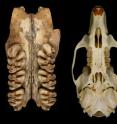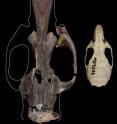Now that's what I call a rat
Archaeological research in East Timor has unearthed the bones of the biggest rat that ever lived, with a body weight around 6 kg. The cave excavations also yielded a total of 13 species of rodents, 11 of which are new to science. Eight of the rats weighed a kilogram or more. "East Indonesia is a hot spot for rodent evolution. We want international attention on conservation in the area," CSIRO's Dr Ken Aplin says.
"Rodents make up 40 per cent of mammalian diversity worldwide and are a key element of ecosystems, important for processes like soil maintenance and seed dispersal. Maintaining biodiversity among rats is just as important as protecting whales or birds."
Carbon dating shows that the biggest rat that ever lived survived until around 1000 to 2000 years ago, along with most of the other Timorese rodents found during the excavation. Only one of the smaller species found is known to survive on Timor today.
"People have lived on the island of Timor for over 40,000 years and hunted and ate rats throughout this period, yet extinctions did not occur until quite recently," Dr Aplin says.
"We think this shows people used to live sustainably on Timor until around 1000 to 2000 years ago. This means extinctions aren't inevitable when people arrive on an island. Large scale clearing of forest for agriculture probably caused the extinctions, and this may have only been possible following the introduction of metal tools."
Each of the islands of eastern Indonesia evolved it own unique collection of rats. Dr Aplin has also found six new rat species in a cave on the island of Flores. Some of these might still be living on Flores but they have evaded detection by modern collectors and further surveys are urgently needed.
Timor has few native mammals, with bats and rodents making up the majority of species. Most of Timor today is arid, transformed from the lush rainforests of the past. But there is still room for imagination.
"Although less than 15 per cent of Timor's original forest cover remains, parts of the island are still heavily forested, so who knows what might be out there?" Dr Aplin says.
"During a recent field trip in East Timor, I found the remains of a freshly dead rat which we knew about only from cave deposits."
Until Dr Aplin finds a larger one, today's biggest rats weigh around 2kg and live in rainforest in the Philippines and New Guinea.
'Quaternary murid rodents of Timor' by Ken Aplin of CSIRO and Kris Helgen of the Smithsonian Institution was published this week in the Bulletin of the American Museum of Natural History.
Source: CSIRO Australia
Other sources
- Biggest Rat That Ever Lived: Weight of About 13 Lbfrom Science BlogMon, 26 Jul 2010, 23:07:22 UTC
- Now that's what I call a ratfrom PhysorgMon, 26 Jul 2010, 16:42:38 UTC
- Discovered: The Biggest Rat That Ever Livedfrom MSNBC: ScienceMon, 26 Jul 2010, 15:14:24 UTC
- Archaeologists discover biggest rat that ever lived: Weight of about 6 kilograms (over 13 lb)from Science DailyMon, 26 Jul 2010, 14:28:11 UTC

